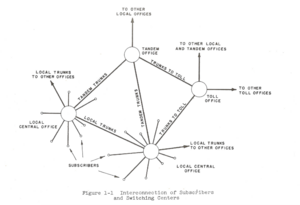Trunk

In telephony, a trunk is a path between two central offices. A trunk can be a set of physical wires, or it can be another type of facility such as a channel on a carrier system. The limiting factor is that (in electromechanical switching) there is one call per trunk at a time.
Trunks contrast with lines, which are the physical links between a subscriber and their telephone exchange.
History
In the earliest forms of telephony, trunks between exchanges were not strictly necessary, as exchanges only connected subscribers to one-another. However, within a short time, it became necessary to interconnect subscribers who were served by different exchanges. Thus, the concept of a trunk was developed.
The earliest trunks were metallic, meaning that they consisted of a pair of wires. This type of trunk was common throughout the 20th Century, and still exist today. By the 1950s, carrier trunks were becoming more and more common. In carrier systems, the voice signal is modulated onto a high-frequency carrier, and several of these modulated carriers, each carrying a conversation, was combined into a carrier group, which then connected two distant points together.
